What is a boilerplate?
A boilerplate is a standardized last paragraph that is inserted in all the press releases giving an outline of the company’s products, services, clients, awards, its purpose and positioning, and often, its size, presence, key locations as well as its website and social media profile links.
When it comes to writing a company boilerplate you might have heard this saying:
“Start from the bottom.”
What this means is that when you’re writing a press release, you should start with the company boilerplate first. This standardized copy is about your business and it appears at the bottom of every press release (hence, “start from the bottom”). It is used in all communications sent to journalists and bloggers when doing public relations to get press coverage.
A good company boilerplate will have an immense impact on all your press outreach.
In this post, I’ll show you how to cook up a deliciously impactful company boilerplate and get the most out of your press releases.
What is a Company Boilerplate?
See this bit of text at the bottom of this press release by Apple about the iMac Pro?

The same text appears verbatim at the bottom of another press release about the iPhone X.
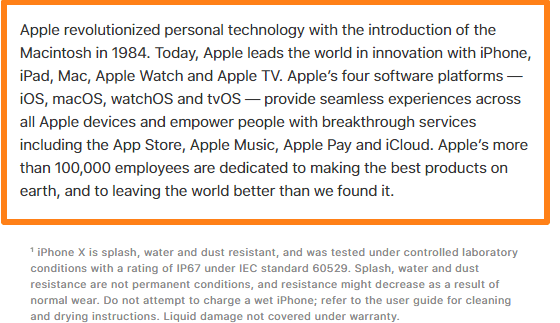
What’s going on? Is Apple getting lazy? Is it running out of copywriters?
Neither, of course.
What you’re looking at is Apple’s company boilerplate.
A company boilerplate is a few paragraphs of text about the company that goes at the bottom of all its press releases. This text describes the company, its purpose, and often, its size, presence, and chief locations.
The boilerplate text is standardized, i.e. it is used on every press release with little to no change. You might make a few minor tweaks for different releases, but the overall text remains largely the same. If a company changes its boilerplate copy, it’s usually just to update some facts.
Although often overlooked, the company boilerplate is an important part of any PR campaign.
In the next section, I’ll discuss the importance of the boilerplate.
What is the Purpose of the Company Boilerplate?
As this Fractl survey revealed, 57% of journalists receive between 50 and 500 pitches each week.
Another survey found that journalists spend less than one minute reading press releases – and that’s for releases they actually opened!
Put yourself in the shoes of a journalist. You’re going through dozens of emails pitching press releases every day. They all seem to sound similar and come from companies you can neither recognize nor remember.
You wonder: Did I write about this company earlier? Or was it another similarly named company?
This is where company boilerplates help. By standardizing the ‘about’ text, you add much-needed consistency and clarity to your press releases. Since the boilerplate remains the same, it cues journalists into your company’s description across different releases.
It makes journalists’ jobs easier and helps them remember your company better. A win-win for everyone involved.
That’s just one of many different uses of company boilerplates. Some other uses and benefits are:
- Saves time: Every press release requires an about section. Having a polished and proven boilerplate text ready saves you tons of time when you’re drafting a new release.
- SEO: The boilerplate text is repeated across all your press releases which are subsequently published by hundreds of sites. Adding your target keywords in the text ensures that your business name gets associated with said keywords. Think of it as an example of an author trust signal – Google will start associating your business’ name with a keyword if it sees the two placed together consistently. You can also add keyword-rich links in the boilerplate for added SEO benefits.
- CTAs: You can add targeted CTAs in your boilerplate and direct all traffic to a relevant page. For example, here is Amtrak’s press release with a link to its blog and social media profiles:

- Easier searchability: Journalists researching your business can search for your boilerplate text and find all press releases from your company. Alternatively, adding relevant keywords to the press release ensures that journalists can find your release when searching through a press release database.
Beyond all of these practical benefits, having a company boilerplate is simply standard industry best practice. Journalists will ask for your boilerplate. So will PR agents. It’s just something you have to do when you write press releases.
As your business grows, it will need to reach out to the press more and more. A new investment, a new launch, a key hire, a big milestone – all of these warrant press releases. Creating separate boilerplates for all these stories will waste your time and create an inconsistent brand image. So create a standard boilerplate you can use for all stories. You can modify this slightly for topic specific boilerplates (say, a boilerplate about new launches can mention your product line, one about a new key hire can mention your leadership team’s experience, etc.). If you’d rather just get press mentions without all this hard work, just hit me up at JustReachOut and I’ll fix you up!
Implement this tactic right now with our software.
Where Does the Boilerplate Go in the Press Release?
This one is simple easy enough to answer – the company boilerplate always goes at the bottom of the press release, but above the company/PR person contact information.
A typical press release follows this format:


This format facilitates the reverse pyramid structure. That is, the freshest and most important information goes at the top. Repetitive or less important information goes at the bottom.
Thus, the company boilerplate – which is not crucial to the actual news in the press release – finds a spot near the bottom.
For best results, I encourage you not to tinker with this format. Journalists have a workflow where they’re used to seeing the title-content-boilerplate structure. Changing it won’t make for a happy journalist.
Examples of Company Boilerplates
Before I share tips and tactics for writing more effective boilerplates, let’s take a look at a few examples from some of the world’s leading companies.
(Hint: every large company maintains a separate ‘newsroom’ section on its website where you can find all its press releases. Use it to get a feel for how effective press releases are written.)
Here’s one from MediaTek, a Taiwan based semiconductor manufacturer. It does a great job of explaining what the company does.
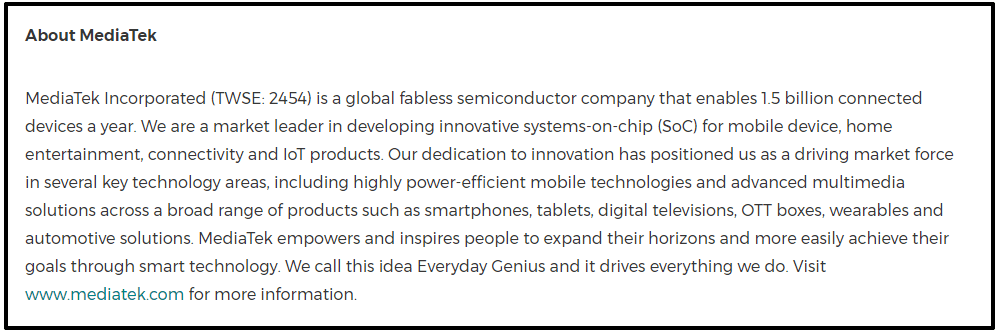

Did you notice all the keywords peppered throughout the boilerplate? This ensures that if a journalist was to search a press release database for those keywords, MediaTek’s release would show up.
Another common practice in boilerplates is to include data about the company’s size, revenue or employee count. Here’s a great example from Domino’s Pizza showing this practice:
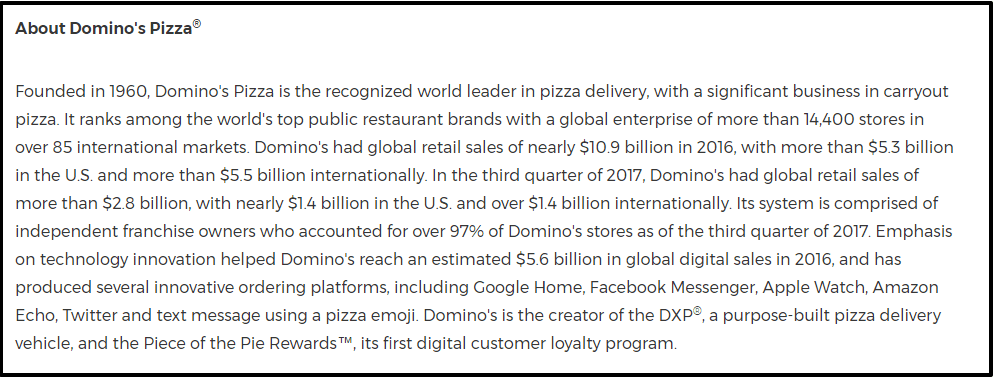

From store count and revenue to market presence and founding date, this press release includes a ton of numbers to give readers an idea of the kind of company they’re dealing with.
What about a press release from a smaller company?
Here’s one example from Phyn, a new water purifier company:


It’s a common practice to mention your backers if you’re a young company, especially if the backer itself is well-known. Phyn does exactly that in the above example.
Another practice is to mention any major awards or rankings your company has been featured in. UberMedia does exactly that in this release:


It mentions all the rankings (WSJ’s “Top 50 Startups”) it has been a part of. The goal is to give readers (i.e. journalists) an idea of the company’s size, growth and potential.
In fact, this should be your primary aim when writing any boilerplate: get journalists interested. If you’re a large company, you can do this by showcasing your size and new initiatives (as in the Domino’s Pizza example above).
If you’re a smaller company, hook in journalists by talking about your established backers, new technologies, and growth.
What Not to Do: Bad Examples of Company Boilerplates
Before I discuss how to actually write a great boilerplate, let me share some examples of what not to do when writing company boilerplates.
Here’s one from GE. Although GE is a household name, this boilerplate is filled with jargon and buzzwords. You can’t really tell what GE does just by reading the boilerplate alone.


It’s also a good practice to keep boilerplates short. You don’t want to write the next War and Peace here.
NBCUniversal’s boilerplate misses the mark precisely because of its verbosity.


While you want to keep things short, you don’t want to keep them too short, like this one:


It tells you nothing about the company or its products, except for its location.
In the next section, I’ll share 8 actionable tips for writing effective company boilerplates.
How to Write Effective Company Boilerplates
Writing an effective company boilerplate is essentially a matter of balancing three things:
- Factual data about the business
- The business’ vision and purpose
- Your marketing goals
To do this, you have to first understand the purpose of the boilerplate, collect relevant data, and condense everything into a succinct, one paragraph statement.
Here are 8 tips you should follow when writing the boilerplate:
1. Educate & Attract Journalists
When you are write a press release, remember the three most important things that journalists look for in a story
- The newsworthiness of the story itself. “Company finds cure for cancer” is newsworthy by itself, regardless of who’s releasing it.
- The impact and importance of the business behind the story. A new acquisition by Google is important; one by a local small business likely isn’t.
- The relevance of the story and the business. Journalists have their own area of coverage (called ‘beats’) and like to cover stories/businesses in those beats only.
The first step in writing an effective boilerplate, therefore, is to give journalists all the information they need about the business. At the same time, you also want to attract their attention by indicating your business’ impact, growth and relevance.
Your goal is to give journalists a compelling reason to write about you.
To do this, there are a few things you need to figure out first:
- Business description: What does your business exactly do? What areas does it cover? Think of this as a succinct version of your ‘about’ page. Use a one-sentence pitch to nail this down. This structure works well for most businesses:
“<Company name> is developing <offering> to help <target audience> <solve a problem> with <a secret sauce>” - Business size: How big is your company in terms of revenue, employee count, and global presence? This tells journalists a lot about your business’ relevance.
- Industries and competencies: What industries does the business operate in? What are your core competencies? This will help journalists figure out whether they should write about your business. A journalist who writes about mobile tech startups likely won’t be interested in a mining company.
- Initiatives and developments: Does your business have any key initiatives and developments? Does it have any innovative products? Listing these will help journalists figure out if your business is “newsworthy”.
- Growth, awards and recognition: Does your business have impressive growth rate? Has it won top industry awards? List these to attract the interest of journalists. A story about a Fortune 1000 company is more interesting than one by a no-name business.
Collecting all this information will help you figure out what to focus on, what to ignore when you write the boilerplate.
2. Market Your Business and Its Products
If one part of the boilerplate is to attract the interest of journalists, the other part is to market your own business and its products.
To do this, there are a few things you should identify first:
- Keywords: Make a list of keywords that describe your business, product or story (such as ‘IoT’, ‘crypto’, ‘social media marketing’, etc.). Use the same keywords that journalists themselves use when writing about your industry. Adding them to the boilerplate is not only good for SEO, but will also help journalists find your press release when they search for these keywords.
- Products: List out any products or developments you want people to know about. Since the press release will be published widely, identifying products in the boilerplate itself will direct attention to them.
- CTAs and anchors: What URLs do you want to divert traffic to? What anchor text do you want to use with these URLs? Identify these before you start writing the boilerplate. Keep in mind that not every press release site will allow you to use anchor text with URLs. Don’t go overboard with URLs either – it’ll just come across as spammy. Stick to one URL, two if you really have to.
- Vision: The boilerplate can also be a vehicle to share your business’ vision, purpose and slogans. List these out before you start writing.
- Competitors: How are journalists covering other players in your industry? Which of your competitors’ accomplishments are they writing about? Use this to identify the hooks and angles you can use to get journalists interested.
For competitor research, simply search for “[competitor name] + press release”. Skip the competitor’s own newsroom (if it has one) and look at stories about the competitor in press outlets.
In the tech industry, for instance, most stories tend to revolve around new launches, partnerships, hires, investments, and growth numbers.
For example, here are a few stories about Lyft:
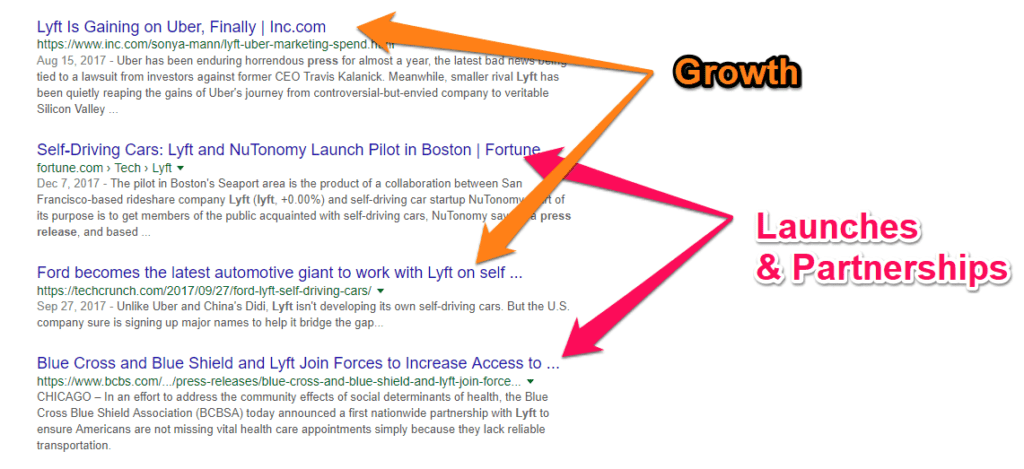

If you were Uber, you’ll probably want to focus on similar themes when pitching journalists.
You can also use the same tactic to find keywords for describing your business. Look for any keywords you see repeated across stories.
In the above example, you can see multiple outlets use “self-driving cars” to describe Lyft:
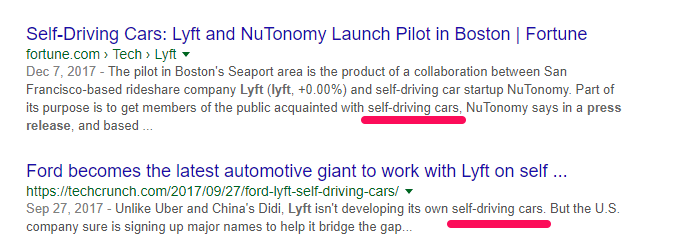

Adding this keyword to your press release will help journalists interested in this space discover it easily.
Once you have all this information, you can combine it with data you gathered earlier (under ‘educate & attract’) to create the boilerplate.
Before you can do that, however, there are a few key facts you should know about the business.
You’re not just competing against your competitors for customers; you’re also competing for the attention of journalists. Researching what your competitors are doing, therefore, should be a big part of your media strategy. Study what kind of stories journalists write about them. What hooks and angles do they use? What do they emphasize – “newness”, “company size”, “company growth”? What sort of keywords do journalists use to write about your competitors? All of these will help you figure out your own approach. If you’d rather let someone experienced do this for you, hit me up at Just Reach Out. We’ll help!
Implement this tactic right now with our software.


3. Collect Key Data
Boilerplates are all about numbers – revenues, employee count, location, etc.
Before you start writing, there are a few things you should list out:
- Number of employees: Include the number of employees the business has (but only if it is substantial enough – say, over 500).
- Location(s): Include the company’s primary location as well as international presence, if any.
- Revenue: If the business has substantial revenue or valuation, include it in the boilerplate.
- Founders and key personnel: If the company has well-known founders or key employees, make sure to include it in the boilerplate.
- Funding: If you’ve received substantial outside funding, it’s a good idea to include it, especially if it comes from reputed sources (such as “Y Combinator funded startup”).
- Users/customers: A large number of customers or users deserves a mention in the boilerplate.
- Year of founding: If the company’s founding date is relevant (say, it was founded 50 years ago), it should get a mention.
- Stock ticker symbol: If the company is publicly traded, you should include its stock ticker symbol at the start of the boilerplate.
- Other data: Besides the above, include any other relevant data (“recipes uploaded”, “messages sent”, “pictures taken”, etc.) in the boilerplate as well.
If you’re a non-profit organization, you should include the following in your non-profit boilerplate as well:
- Number of volunteers/members
- Funding or donations received/solicited
- Number of people served
- Number of people affected
4. Write a Positioning Statement
Facts about the company’s employee count, revenue, and product line are nice, but what really sells the boilerplate is the positioning statement.
This is a single line about what makes your company unique and why it deserves to be written about.
Maybe you are the largest provider of vending machines in the state of New York. Maybe you were the first to pioneer distributed cryptocurrency mining. Or maybe you have a product used by 60% of all Fortune 500 companies.
Think of such accomplishments then write a single sentence about it. This will be your positioning statement.
Some things you can include in this statement are:
- Being the first or largest player in an industry or region
- Being backed by a high-profile investor
- Presence in a large number of markets
- Public recognition
For example here is how Helpscout does this:
Help Scout is a dedicated customer service software specifically for the needs of growing businesses. It gives you the simplicity to start right away, the power to grow, and the human-centered approach to turn customers into advocates. 12,000 beloved brands trust Help Scout as the backbone of their support team.
Another example is CourseHero’s positioning statement (highlighted):


Here’s another example from Lyft:


Notice how the company highlights that ti is the “fastest growing” ridesharing company in the US?
Let’s look at a final example from Airbnb:


It’s the same approach – highlight the numbers associated with the business – “millions of unique accommodations” in more than “34,000 cities and 191 countries”.
5. Write the Boilerplate Draft
At this point, you have all the information you need to write the first draft of your company boilerplate.
A good practice is to start with the company’s location, area of expertise and business purpose. Something like “XYZ is a New York City-based pharmaceutical company aimed at providing cancer treatment for underprivileged patients”.
From here, you can cover the business’ key products and innovations. Mentions of the business’ size, growth and key awards/recognitions would go well here.
For example, this boilerplate from CVS Health starts by identifying the business’ purpose before covering its size and products.


Make sure to include your positioning statement and any public awards/recognitions.
A few tips to follow when writing your boilerplate draft:
- Be specific: Be as specific as possible when writing about your business. For instance, if you sell smart home products, mention that you’re an IoT company, not just a ‘technology’ company.
- Back claims with data: Any claims you make must be backed with data. For example, If you say you’re a “large” company, back it up by mentioning your employee size, market presence or revenue.
- Be concise: Keep the boilerplate limited to a single paragraph. If you must stretch to two paragraphs, use the second one for CTAs and positioning statements only. Anything under 120-150 words is ideal. Beyond that you risk losing your readers’ interest.
- Remove jargon: Your press release is meant for journalists, not industry experts. Remove any jargon and filler words from the boilerplate.
This will just be the first draft of the boilerplate. In the next steps, you’ll refine it further by adding keywords and CTAs.
6. Add Keywords
Keywords serve a crucial role in company boilerplates. They help journalists find your story in press release databases. Conversely, PR databases use keywords to better categorize your news stories.
At the same time, using targeted keywords helps search engines rank your press release for said keywords.
Once you’ve wrapped up the first draft of your boilerplate, add relevant keywords to it. These should be broad keywords that describe your company (ex: “smart devices manufacturer”) and its products (ex: “smart LED bulbs”).
For example, here’s how LivePerson uses keywords in its boilerplate:


7. Add CTAs
The final part of the boilerplate should be a CTA. This can be a URL, a phone number, an email address, or even a physical address.
It’s important to note if you have a job where you work from home such as data entry clerk, of contact center rep, you will most likely need to get a secondary phone number for your company.
Before adding a CTA, think of your boilerplate marketing goal. What do you want to achieve with the press release? Do you want to direct traffic to your website? Get more calls from customers?
Once you’ve figured this out, create a CTA that supports your marketing goal.
For example, if your goal is to get traffic to your website, your CTA would be your website URL. If you want to get calls, include your phone number.
A couple of things to keep in mind before adding your CTA:
Most press release sites limit the number of URLs you can include in the release. Add only the most relevant URLs to the boilerplate.
Press releases are often published as text-only. A long URL or one with anchor text might not be clickable, limiting the traffic you can get from it. Thus, keep your URLs short and easy to type-in in case people can’t click them.
A single press release might be published by hundreds of outlets, many of which are of dubious quality. A large number of poor quality links to interior pages can trigger Google’s spam filters. Therefore, it’s a good practice to link to your homepage only.
Here’s an example of a CTA directing readers to a website:


8. Review and Update
Finally, make sure to review your company boilerplate frequently. This isn’t supposed to be a static document. As your company grows, launches new products, and creates new campaigns, review the boilerplate and update it accordingly.
Over to You
The company boilerplate is one of the most important parts of any press release. It tells journalists what your company is about and why they should write about it. It also helps market your business and its products to journalists and anyone else who reads the release.
Writing an effective company boilerplate is about balancing the company’s objective data and subjective mission statement. You should include hard data about the company’s size, location, products, and innovations. At the same time, you should also include subjective positioning statements, competencies, and public awards.
How would you position your company in your boilerplate? Leave a comment with your positioning statement and I’ll share my thoughts on it below!
- What is a boilerplate?
- What is a Company Boilerplate?
- What is the Purpose of the Company Boilerplate?
- Where Does the Boilerplate Go in the Press Release?
- How to Write Effective Company Boilerplates
- 1. Educate & Attract Journalists
- 2. Market Your Business and Its Products
- 3. Collect Key Data
- 4. Write a Positioning Statement
- 5. Write the Boilerplate Draft
- 6. Add Keywords
- 7. Add CTAs
- 8. Review and Update
- Over to You

I used to write my company name and contact number in the boilerplate. I had no idea that you could fit a ton of information! Going to try this next time I write a press release.
Hi Dmitry, thank you for this insightful article! You wrote about what company information should be included in the boilerplate, but what facts should you leave out of the boilerplate at all costs?
Hi Jim, This is a good question. What you must not put in a boilerplate is industry jargon and buzzwords. Don’t make it too long or verbose either. Boilerplate needs to give a ton of information while being precise and easy to understand.
Hope this helps!
Dmitry, I just started a business but I don’t have many achievements to brag about in the boilerplate. What can I do to make my boilerplate stand out?
Hi David, Why not add crucial keywords related to your industry? It can help your company get discovered through Google. Also add a link to your website so you can redirect the traffic you received from your press release. All the best for your new endeavor!
My boilerplate: TD Games is an independent developer and publisher of games for handheld platforms. We are an emerging pioneer in highly personalized mobile games. With a total of 35 custom games, we aim to carve a niche in the gaming industry.
Hi Janine! This is fantastic.
Just a few pointers: Where is your company located? Your address can help potential clients connect with you with ease. Have you received any funding? This fact is great for journalists to identify growing startups.
Hi Dmitry, great post! I have used the strategies here to write a killer boilerplate 🙂 and added it to my press release. Can you tell me how to pitch this press release to journalists? Should I just send an email with the release as an attachment?
Hi Robin,
Pitching to relevant journalists is not complicated at all but you cannot under any circumstances send a press release as an attachment in an email. It will never get noticed. I recently wrote a definitive guide on pitching to the media so that they respond: https://blog.justreachout.io/media-pitch/
Hope this helps!
Fantastic article! But I’m dying to know the mystery of #4! 😉
Thanks for the kind words. Come again re: mystery in #4?
It just looks like Step 4 is missing. 😉
But yes, very good article. I keep coming back to it for reference.
Looks like it’s been corrected Mike. Step 4 is back! 🙂 And yes, couldn’t agree more, this is a great article on boilerplate.
Such a helpful article! If I’m writing a press release for an event that has multiple collaborators/sponsors, should/can I include more than one boilerplate? If not, how does one choose which company to feature?
Hey Megan, great question. Usually I would choose the company which is the main one hosting the event so that all press inquiries and any contact requests go to that company and they can properly answer them. Most of the time they deserve the spotlight anyways. Does this make sense?
That makes great sense. Thank you, Dmitry!!